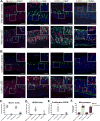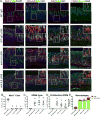A signalling cascade of IL-33 to IL-13 regulates metaplasia in the mouse stomach
- PMID: 28196875
- PMCID: PMC5681443
- DOI: 10.1136/gutjnl-2016-312779
A signalling cascade of IL-33 to IL-13 regulates metaplasia in the mouse stomach
Abstract
Objective: Alternatively activated macrophages (M2) are associated with the progression of spasmolytic polypeptide-expressing metaplasia (SPEM) in the stomach. However, the precise mechanism(s) and critical mediators that induce SPEM are unknown.
Design: To determine candidate genes important in these processes, macrophages from the stomach corpus of mice with SPEM (DMP-777-treated) or advanced SPEM (L635-treated) were isolated and RNA sequenced. Effects on metaplasia development after acute parietal cell loss induced by L635 were evaluated in interleukin (IL)-33, IL-33 receptor (ST2) and IL-13 knockout (KO) mice.
Results: Profiling of metaplasia-associated macrophages in the stomach identified an M2a-polarised macrophage population. Expression of IL-33 was significantly upregulated in macrophages associated with advanced SPEM. L635 induced metaplasia in the stomachs of wild-type mice, but not in the stomachs of IL-33 and ST2 KO mice. While IL-5 and IL-9 were not required for metaplasia induction, IL-13 KO mice did not develop metaplasia in response to L635. Administration of IL-13 to ST2 KO mice re-established the induction of metaplasia following acute parietal cell loss.
Conclusions: Metaplasia induction and macrophage polarisation after parietal cell loss is coordinated through a cytokine signalling network of IL-33 and IL-13, linking a combined response to injury by both intrinsic mucosal mechanisms and infiltrating M2 macrophages.
Keywords: CELLULAR IMMUNOLOGY; CYTOKINES; GASTRIC PRE-CANCER; GASTRITIS; MACROPHAGES.
Published by the BMJ Publishing Group Limited. For permission to use (where not already granted under a licence) please go to http://www.bmj.com/company/products-services/rights-and-licensing/.
Conflict of interest statement
Competing interests: None declared.
Figures







Similar articles
-
Macrophages promote progression of spasmolytic polypeptide-expressing metaplasia after acute loss of parietal cells.Gastroenterology. 2014 Jun;146(7):1727-38.e8. doi: 10.1053/j.gastro.2014.02.007. Epub 2014 Feb 15. Gastroenterology. 2014. PMID: 24534633 Free PMC article.
-
WFDC2 Promotes Spasmolytic Polypeptide-Expressing Metaplasia Through the Up-Regulation of IL33 in Response to Injury.Gastroenterology. 2021 Sep;161(3):953-967.e15. doi: 10.1053/j.gastro.2021.05.058. Epub 2021 Jun 8. Gastroenterology. 2021. PMID: 34116028 Free PMC article.
-
Maturity and age influence chief cell ability to transdifferentiate into metaplasia.Am J Physiol Gastrointest Liver Physiol. 2017 Jan 1;312(1):G67-G76. doi: 10.1152/ajpgi.00326.2016. Epub 2016 Nov 23. Am J Physiol Gastrointest Liver Physiol. 2017. PMID: 27881402 Free PMC article.
-
Injury, repair, inflammation and metaplasia in the stomach.J Physiol. 2018 Sep;596(17):3861-3867. doi: 10.1113/JP275512. Epub 2018 Mar 24. J Physiol. 2018. PMID: 29427515 Free PMC article. Review.
-
Helicobacter pylori plays a key role in gastric adenocarcinoma induced by spasmolytic polypeptide-expressing metaplasia.World J Clin Cases. 2023 Jun 6;11(16):3714-3724. doi: 10.12998/wjcc.v11.i16.3714. World J Clin Cases. 2023. PMID: 37383139 Free PMC article. Review.
Cited by
-
Global knowledge mapping and emerging trends in research between spasmolytic polypeptide-expressing metaplasia and gastric carcinogenesis: A bibliometric analysis from 2002 to 2022.Front Cell Infect Microbiol. 2023 Jan 27;12:1108378. doi: 10.3389/fcimb.2022.1108378. eCollection 2022. Front Cell Infect Microbiol. 2023. PMID: 36776551 Free PMC article.
-
Acid and the basis for cellular plasticity and reprogramming in gastric repair and cancer.Nat Rev Gastroenterol Hepatol. 2018 May;15(5):257-273. doi: 10.1038/nrgastro.2018.5. Epub 2018 Feb 21. Nat Rev Gastroenterol Hepatol. 2018. PMID: 29463907 Free PMC article. Review.
-
Group 2 Innate Lymphoid Cells Coordinate Damage Response in the Stomach.Gastroenterology. 2020 Dec;159(6):2077-2091.e8. doi: 10.1053/j.gastro.2020.08.051. Epub 2020 Sep 4. Gastroenterology. 2020. PMID: 32891625 Free PMC article.
-
Role and research progress of spasmolytic polypeptide‑expressing metaplasia in gastric cancer (Review).Int J Oncol. 2024 Mar;64(3):33. doi: 10.3892/ijo.2024.5621. Epub 2024 Feb 1. Int J Oncol. 2024. PMID: 38299264 Free PMC article.
-
Taking a Step Back: Insights into the Mechanisms Regulating Gut Epithelial Dedifferentiation.Int J Mol Sci. 2021 Jun 30;22(13):7043. doi: 10.3390/ijms22137043. Int J Mol Sci. 2021. PMID: 34208872 Free PMC article. Review.
References
-
- de Martel C, Ferlay J, Franceschi S, Vignat J, Bray F, Forman D, et al. Global burden of cancers attributable to infections in 2008: a review and synthetic analysis. The lancet oncology. 2012;13:607–15. - PubMed
-
- Tatematsu M, Tsukamoto T, Mizoshita T. Role of Helicobacter pylori in gastric carcinogenesis: the origin of gastric cancers and heterotopic proliferative glands in Mongolian gerbils. Helicobacter. 2005;10:97–106. - PubMed
-
- Yoshizawa N, Takenaka Y, Yamaguchi H, Tetsuya T, Tanaka H, Tatematsu M, et al. Emergence of spasmolytic polypeptide-expressing metaplasia in Mongolian gerbils infected with Helicobacter pylori. Lab Invest. 2007;87:1265–76. - PubMed
Publication types
MeSH terms
Substances
Grants and funding
LinkOut - more resources
Full Text Sources
Other Literature Sources
Molecular Biology Databases
Research Materials
